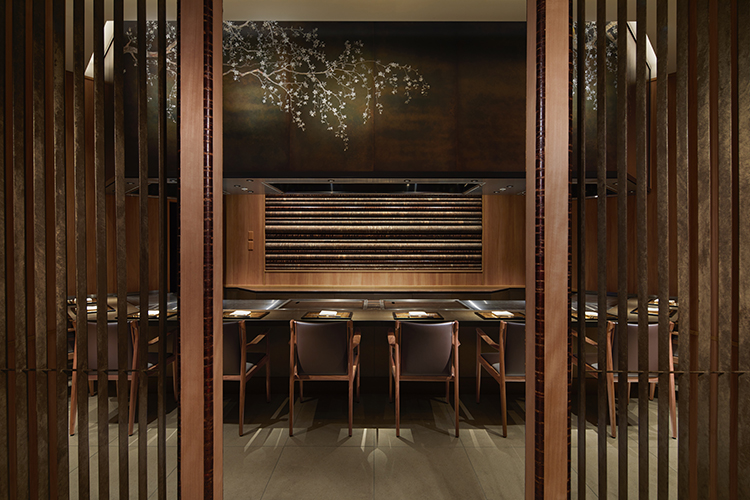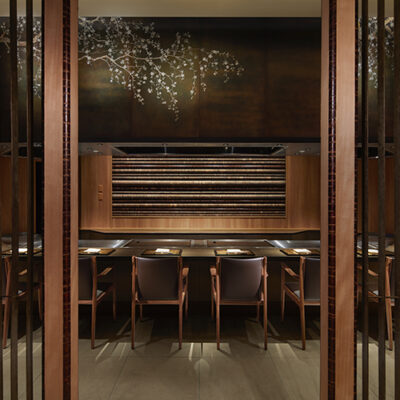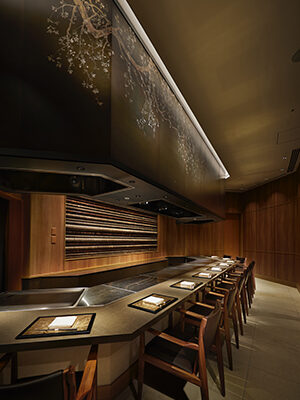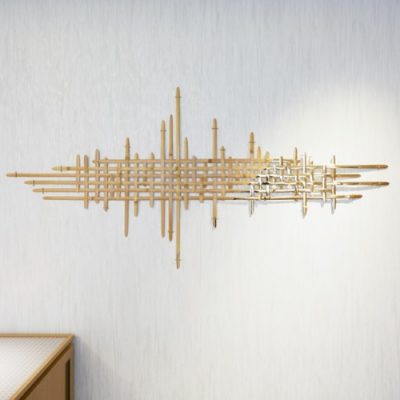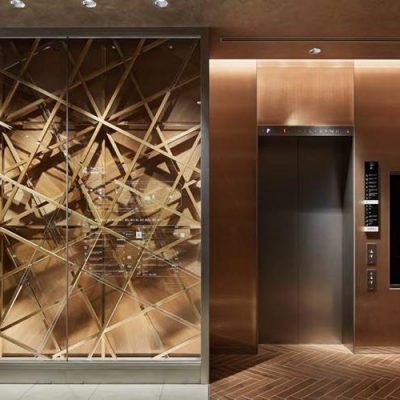セルリアンタワー東急ホテル 鉄板焼 桜 -SAKURA-
WORKS DETAIL
- 事例project name
- セルリアンタワー東急ホテル 鉄板焼 桜 -SAKURA-CERULEAN TOWER TOKYU HOTEL TEPPAN-YAKI SAKURA
- 仕様&素材material
- 絵付けNihonga painting
- デザインdesign
- A.N.D
- 納品時期delivery
- 2019
- 写真photo
- Nacasa & Partners
絵師が咲かせた花
ソメイヨシノの桜並木で知られる渋谷の桜丘町。地名にちなみ、桜の美しさと強さを店名に込めたというホテル内のレストラン「鉄板焼 桜 -SAKURA-」。
「メインとなる鉄板焼きカウンターのある部屋に入った瞬間に目に入るレンジフード、そして、個室ではシェフが立つカウンターの背後にある壁が、このレストランのオリジナリティーを表現する絶好のキャンバスとなるので、そこに象徴的なアクセントが欲しくて。そこで、この二つの面にどう桜をあしらうことができるかを、ubushinaに相談しました」と設計者の小坂竜さんは振り返る。そこで選ばれたのは、伝統技法を用いた手描きのペインティングだった。日本的な間を意識し、シンメトリーではなく左上から枝が降りてくる構図をデザイナーが提案。フードにはあえて細かく目地を入れることで襖絵のようなスケール感とするなど、こだわりは細部にまで及ぶ。そうしたデザイン意図をくみ取り、実際に手を動かしたのは砂子師のN工房・永井聡さんだ。
「レンジフードでは、『静かな奥行き』と『光を描いて欲しい』という要望から、パールや錫などいくつかの金属粉を混ぜ込んだ銀泥を使い、かすかな色の違いを生かして桜を表現しました。一方、個室の壁では、筆で描いた上から、さらに墨を垂らす、“たらしこみ”という琳派の絵師が得意とした技法で花びらや枝の節を表しています。絵と向き合っているときは、描くという意識は実はなくて、気持ちを入れて花を育てていくような感覚で筆を動かしていくんですよ。時々デザイナーのおっかない顔を思い浮かべながらね(笑)」と永井さん。
試作から竣工までの間、ubushinaは筆のタッチ一つにもこだわるデザイナーと絵師の間で通訳の役割を果たし、両者のコミュニケーションを支えた。また、限られた工期の中で、素材の選定から厚みの検討、それぞれ異なる工場での曲げ加工と焼き付け塗装、さらに描画後のトップコートまで、表から見えない工程のすべてを水面下でコントロールし、実現へと導いた。
手間を掛けたアートを使う理由には、小坂さんの空間に対する強い意識が表れている。「カタログで選ぶ素材だけでは、誰がデザインしても同じような印象になってしまう。僕らは今までにないものをつくりたいから、差別化するためにubushinaとコラボレーションして永井さんのような作家の力を借りることもあれば、自然素材の表情を取り入れることもある。アートを使う場合には、壁に掛ける作品では存在が強すぎることがあるので、オリジナルの空間とするためにアートに近づきながら、インテリアとして成立するデザインを探っていく。時間は掛かるけれど、そうやっていかないと違いはつくれない」。
執筆 山倉礼士
Flowers blossoming from the brush
Located in Tokyo’s Shibuya ward, Sakuragaoka-cho is renowned for its rows of Somei-yoshino cherry trees. The area’s name translates to the “hill of blooming sakura (cherry blossoms)” and inspired the naming of Teppan-yaki Sakura, a restaurant inside Cerulean Tower.
The restaurant’s interior designer, Ryu Kosaka, reflects on his collaboration with Ubushina. “The range hood above the main teppanyaki counter, which you see the moment you enter the space, and the wall behind the counter in the private room are the perfect canvases for expressing the originality of the restaurant. We wanted to have iconic features there to accentuate the space and so we contacted Ubushina to discuss how we could decorate the two surfaces with cherry blossoms.” Through their discussions, they decided to use a traditional painting technique. The designer proposed a composition in which cherry branches descend from the upper left corner in an asymmetric manner, staying true to the Japanese concept of ma. This attention to detail extends to the range hood, which was designed with fine joints to create a sense of scale akin to a traditional sliding door painting. Satoshi Nagai of N-Kobo, a painter specialising in sunago (a traditional technique using gold or silver dust), interpreted the design and brought the pieces to life by hand.
“For the range hood, given the request for ‘quiet depth’ and the ‘depiction of light’, I used silver paint mixed with several types of metal powders, including pearl and tin, to express the cherry blossoms with subtle differences in colour,” says Nagai. “On the other hand, for the wall in the private room, tarashikomi (meaning ‘dripping-in’), a special technique used by the Rinpa school of painting, was used to express the flower petals and gnarled branches. When I paint, I don’t actually think of it as ‘painting’. I just put my heart into it and move my brush as though I’m growing flowers, occasionally thinking about the designer’s scary face (laughs).”
From prototyping through to the project’s completion, Ubushina acted as an interpreter, facilitating communication between the designer and the painter, who paid close attention to every brushstroke. Ubushina also played a key role during the limited construction period, managing and completing processes ranging from material selection to bending panels and baking coatings at different factories, and top coating the painting upon completion.
Kosaka’s approach to interior design is evident in his use of such an elaborate work of art. “If you only use materials selected from catalogues, you can end up with the same kind of impression as any other designer,” he says. “We want to create things that have never seen before, which is why we collaborate with Ubushina and artists like Nagai-san or incorporate natural materials. When it comes to artworks, hanging a piece on the wall can sometimes create too strong a presence. In order to maintain the space’s originality, we explore ways to design it to be both viable as an interior and close to an art form. It takes time, but this is the only way to make a difference.”
Writing Reiji Yamakura

